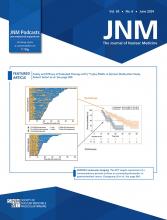Merkel cell carcinoma is a rare, highly aggressive skin cancer. With multimodal treatment including chemo- and immunotherapy, the 5-y overall survival ranges from 14% to 62%, depending on the disease stage at diagnosis (1). New treatment options are therefore urgently needed. Given the overexpression of somatostatin receptors (SSTRs) due to its neuroendocrine features, SSTR-directed therapy could be a promising target in metastatic Merkel cell carcinoma (2–4).
To further investigate this potential, 2 clinical trials are already ongoing in which peptide receptor radionuclide therapy with SSTR agonists are being studied in combination with immunotherapy (GoTHAM trial, NCT04261855; iPRRT trial, NCT05583708).
Although various agonistic SSTR-targeting tracers have been established for years in metastatic Merkel cell carcinoma and other neuroendocrine tumor entities, tracers with antagonistic receptor interaction are recognized as a new, promising theranostic option, as they can achieve high tumor uptake and prolonged retention as compared with agonists (5).
We report the case of a 77-y-old man with recurrent metastatic Merkel cell carcinoma who underwent PET/CT with the 68Ga-labeled SSTR antagonist SSO120 (international nonproprietary name: satoreotide trizoxetan; also known as NODAGA-JR11, OPS202, and IPN01070; injected dose, 160 MBq; scan acquisition, 60 min after injection) (6,7) to explore the possibility for peptide receptor radionuclide therapy (Fig. 1A). Informed consent was obtained from the patient. Compared with [18F]FDG PET (Fig. 1B), a more intense tracer uptake and excellent tumor-to-background ratios were observed using [68Ga]Ga-SSO120 PET, for example, in a pelvic (right iliac) lymph node metastasis with an SUVmax of 11.6 versus 5.5 on [18F]FDG PET. The average SUVmax in the 6 measurable tumor lesions was 13.4 ± 5.0 with [68Ga]Ga-SSO120 versus 9.5 ± 4.2 with [18F]FDG PET. Given the still-localized tumor stage, the patient underwent surgery. High membranous SSTR expression on all tumor cells was confirmed by immunohistochemistry (score 3+; Fig. 1C).
Maximum-intensity projections and axial sections of [68Ga]Ga-SSO120 (A) and [18F]FDG (B) PET/CT. Location of exemplary pelvic (right iliac) lymph node metastasis with SUVmax of 11.6 vs. 5.5 on [18F]FDG PET is indicated by white and black arrows, respectively. Intensity scale bars are SUV. Immunohistochemistry showed high membranous SSTR expression on all tumor cells (score 3+; C).
In conclusion, PET/CT with SSTR antagonists could serve as a noninvasive read-out for tumor biology and allow selection of candidates for SSTR-directed peptide receptor radionuclide therapy. Further research, especially regarding advantages over agonistic vectors, is highly warranted.
DISCLOSURE
No potential conflict of interest relevant to this article was reported.
Footnotes
Published online Feb. 8, 2024.
- © 2024 by the Society of Nuclear Medicine and Molecular Imaging.
Immediate Open Access: Creative Commons Attribution 4.0 International License (CC BY) allows users to share and adapt with attribution, excluding materials credited to previous publications. License: https://creativecommons.org/licenses/by/4.0/. Details: http://jnm.snmjournals.org/site/misc/permission.xhtml.
REFERENCES
- Received for publication November 25, 2023.
- Revision received January 11, 2024.








